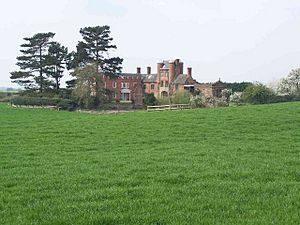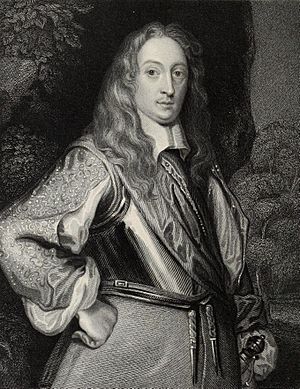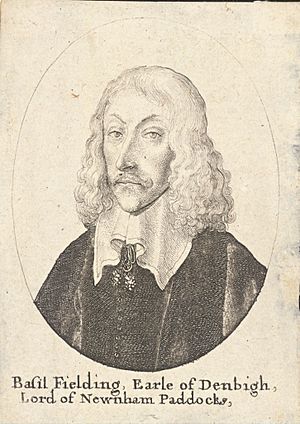Sir Edward Littleton, 1st Baronet facts for kids
Quick facts for kids
Sir Edward Littleton
|
|
|---|---|

Restored remains of Pillaton Hall today, incorporated into a more recent building.
|
|
| Member of the English Parliament for Staffordshire |
|
| In office 1640–1644 Serving with Sir William Bowyer, died March 1641
Sir Hervey Bagot, disabled 24 November 1642 |
|
| Preceded by | Sir Hervey Bagot Thomas Crompton |
| Succeeded by | Sir John Bowyer Sir Richard Skeffington |
| Personal details | |
| Born | c. 1599 |
| Died | c. August 1657 Probably Romford |
| Nationality | English |
| Political party | Country party or Parliamentarian until late 1643. Defected to Royalists. |
| Spouses | Hester, daughter of Sir William Courten |
| Relations | Robert Devereux, 3rd Earl of Essex Richard Knightley |
| Children | Sir Edward Littleton, 2nd Baronet, two other sons and two daughters. |
| Residence | Pillaton Hall |
| Alma mater | Brasenose College, Oxford |
| Occupation | Landowner |
Sir Edward Littleton, 1st Baronet (born around 1599 – died around 1657) was an English politician and a Baronet in the 1600s. He was the first of four Baronets from the Littleton family who lived at Pillaton Hall.
At first, he supported the Parliamentarians during the English Civil War. He tried to find a middle way, but when that failed, he switched to support the Royalists. This choice led to big money problems for him. He lost his lands because he couldn't pay off his large debts after Parliament won the war.
Contents
Early Life and School
Edward Littleton was born in 1598 or 1599. We know this because he was 18 when he started at Oxford University in 1617. His father was also named Sir Edward Littleton and lived at Pillaton Hall in Staffordshire. His mother was Mary Fisher from Warwickshire.
Both of Edward's parents came from important land-owning families, known as the landed gentry. His mother's family, the Fishers, owned land and had influence in Warwickshire.
There had been many Edwards Littleton at Pillaton Hall before him. It can be confusing because another famous Edward Littleton, Edward Littleton, 1st Baron Lyttelton, was also active in Parliament around the same time. All the Littletons from Staffordshire, Worcestershire, and Shropshire were related to Thomas de Littleton, a famous judge from the 1400s.
The Littleton family in Staffordshire had a history of being a bit rebellious. Edward's grandfather had supported a powerful nobleman, the Earl of Essex, and was even arrested for a short time. Edward's father was thought to have strong Protestant beliefs and supported a minister who was not popular with everyone. The family also kept their connection to the Earl of Essex, who was a powerful friend and relative.
Young Edward went to Brasenose College, Oxford, in 1617. He then joined the Inner Temple, a place where people studied law, in 1618. His legal studies were probably just to give him the basic knowledge needed to manage his family's estates. This was different from his younger brother, Walter, who had a more academic career. The family's money situation improved around this time, and they returned to Pillaton Hall.
Marriage and Special Titles
Once Edward grew up and the family had more money, they were able to buy him a knighthood. He became a knight on August 22, 1621, in Warwick.
In 1625, he married Hester Courten. Her father, Sir William Courten, was a very rich merchant from London. He was involved in textiles and finance. Sir William wanted his children to marry well. He paid a large dowry of £5000 to the Littletons, which was a huge amount of money back then. This dowry helped the Littletons, who were not as wealthy as the Courten family.
It was likely this large dowry that allowed Edward to buy a baronetcy. A Baronet is a special title, like a hereditary knight, that was bought from the King. King Charles I gave Edward this title on June 28, 1627.
The Ship Money Tax
After his father passed away, Edward Littleton became more involved in local politics. He served as the High Sheriff of Staffordshire from 1636 to 1637. This was during a time when King Charles I was trying to collect a tax called ship money without Parliament's approval.
Littleton seemed unsure about collecting this tax. He wrote to the King's council, saying that people in his county were refusing to pay. He explained that they were upset because the tax was much higher than before. He said he was trying his best but found it very difficult. He even mentioned that people would come to his house and tell him to take their belongings because they had no money to pay.
Later, the next Sheriff suggested that Littleton had been too easy on people. This made some people think that Sir Edward was secretly on the side of the people, not the King, even though he claimed to be trying hard to collect the tax.
Moving Towards War
Littleton became a Member of Parliament for Staffordshire in 1640. He served in both the Short Parliament and the Long Parliament. At first, he was a trusted member of Parliament. He was given important tasks and joined many committees. For example, in 1641, he was on a committee to prevent dangers from "Popish Recusants" (Catholics who refused to attend Church of England services). He also agreed to the "Protestation," promising to defend the Protestant religion.
As England moved closer to civil war, Littleton remained a strong supporter of Parliament. In June 1642, he wrote to his friend Sir Richard Leveson, another MP, saying that Parliament expected all members to be present or face a large fine. He also told Leveson about the King's plans to raise an army. Leveson tried to stay neutral but eventually joined the Royalists. Littleton, however, quickly sided with Parliament.
Parliament even ordered him to tell his father-in-law, William Courten, not to sell his saltpetre (a key ingredient for gunpowder), as Parliament wanted to buy it. In August, the King tried to appoint Littleton to a high position in Staffordshire to weaken his ties with the Earl of Essex, a Parliamentarian leader. But this didn't work.
Parliament's Work
By early 1643, the Royalists controlled most of Staffordshire. Parliament launched a counter-attack led by Robert Greville, 2nd Baron Brooke, who was Littleton's neighbor. Lord Brooke captured Stratford-upon-Avon and then attacked Lichfield. He was killed during the siege, but Parliament's forces won.
Littleton was ordered to write a thank-you letter from Parliament to the soldiers who won at Lichfield. He was also put in charge of some captured saddles to be given to troops in his county.
In March 1643, Littleton was asked to help enforce a law to take over the lands of "notorious delinquents," which meant Royalists. He was also involved in raising money for Parliament and agreed to continue the war to defend the Protestant faith. Even in August, he was still on a committee dealing with MPs who left Parliament.
Changing Sides
By November 1643, Parliament was trying to get Littleton to return from his leave. By December, they were demanding his immediate return. But in January 1644, he joined the Oxford Parliament, which was set up by the King. On March 4, he was officially removed from the Westminster Parliament for "neglecting the Service of the House, and going to the other Party."
Details about why Littleton changed sides came out later, in 1649. It was part of an investigation into whether a Parliamentarian commander, the Earl of Denbigh, had secretly tried to help the King. It was said that Littleton had announced in Staffordshire that he was raising troops for Denbigh, possibly to create a "third party" that wasn't fully for Parliament or the King. However, he ended up joining the King's side.
Littleton continued to fight for the Royalists until the very end of the war in the Midlands. He was present at the siege of Worcester, which ended in July 1646.
Losing His Estates
After Parliament won the war, Littleton's lands were taken over, a process called sequestration. Even before he surrendered in 1646, Parliament gave away one of his small estates. He was listed as a "delinquent" (a Royalist who fought against Parliament) in 1648.
Littleton tried to "compound" for his estates, which meant paying a fine to get them back. But he couldn't because he had huge personal debts and had also guaranteed a massive loan for his father-in-law. Because of these debts, he was unable to pay the fine required to get his lands back.
Many people who were owed money by Littleton, or who had claims on his land, tried to get parts of his estates. For example, his brother, Fisher Littleton, tried to buy back some of the family lands. He claimed he was one of Sir Edward's main creditors. In December 1650, Fisher was able to get some of the land back for the family by paying a fine.
In 1652, Parliament decided to sell the remaining lands of Royalists to pay off their debts. Littleton asked for his name to be included, and it was. Fisher Littleton continued to work hard to buy back more of the family's estates. By 1653, he had recovered several Staffordshire estates.
Death
Sir Edward Littleton is believed to have been buried at St Edward the Confessor Church, Romford on August 3, 1657.
Family Life
Sir Edward Littleton and his wife, Hester Courten, had three sons. Two of them, James and William, died without having children. Their surviving son and heir was Sir Edward Littleton, 2nd Baronet, who became the next Baronet. They also had two daughters: Anne and Margaret. Anne married Sir Thomas Holte and later Charles Leigh.
|






